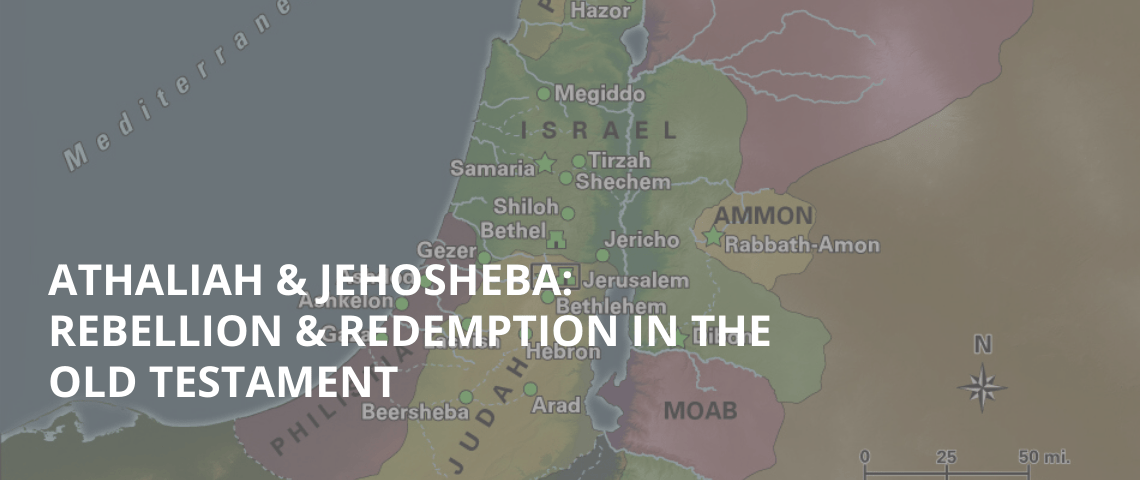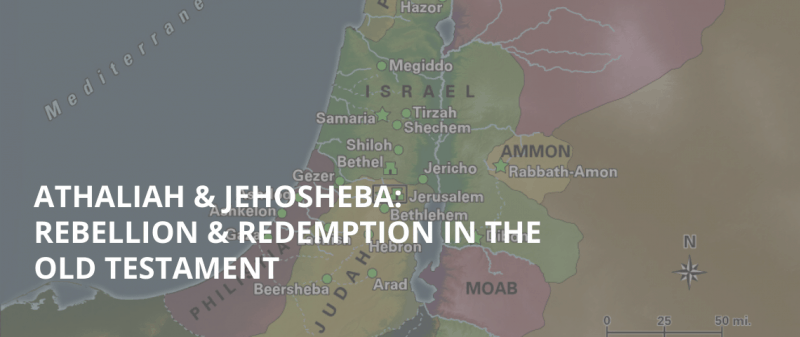Redemption is one of the most beautiful themes in the Bible.
God creates something good but it’s subverted for evil – God comes in again and redeems it, giving it back the purpose and goodness it was meant to have. We often think of ‘Christ the redeemer of our souls’, but redemption is more than that – God wants to redeem all of creation. The movement for women’s equality can be seen as the redemption of the relationship between men and women, bringing us back to God’s original good design.
I want to examine a wonderful glimpse of this redemption, found in the Old Testament books of 2 Kings and 2 Chronicles:
The people of Jerusalem made Ahaziah, Jehoram’s youngest son, king in his place, since the raiders, who came with the Arabs into the camp, had killed all the older sons. So Ahaziah son of Jehoram king of Judah began to reign. Ahaziah was twenty-two years old when he became king, and he reigned in Jerusalem one year. His mother’s name was Athaliah, a granddaughter of Omri. He too followed the ways of the house of Ahab, for his mother encouraged him to act wickedly. He did evil in the eyes of the Lord, as the house of Ahab had done, for after his father’s death they became his advisers, to his undoing.” 2 Chronicles 22:1-4 NIV
When King Ahaziah dies, it seems none of his children are old enough or have enough power and influence to take the throne, so his mother Athaliah steps in:
When Athaliah the mother of Ahaziah saw that her son was dead, she proceeded to destroy the whole royal family of the house of Judah. But Jehosheba, the daughter of King Jehoram, took Joash son of Ahaziah and stole him away from among the royal princes who were about to be murdered and put him and his nurse in a bedroom. Because Jehosheba, the daughter of King Jehoram and wife of the priest Jehoiada, was Ahaziah’s sister, she hid the child from Athaliah so she could not kill him. He remained hidden with them at the temple of God for six years while Athaliah ruled the land.” 2 Chronicles 22:10-12 NIV
Athaliah was the daughter of Jezebel and King Ahab of Israel [1]. Her marriage to King Jehoram of Judah was a political alliance that eased the tensions between the two kingdoms but also brought the negative influence of her family line along with it. Upon the death of her son the king, she seizes the throne and all the young heirs are set to be murdered [2]. Can we pause and think about how evil that is? Murdering your very own grandchildren in order to seize power?
In the face of that atrocity, only one person stands in the way – the Princess Jehosheba. The daughter of Athaliah’s deceased husband, King Jehoram [3], Jehosheba hides the young Joash and his nurse to prevent him from being murdered. She and her husband, the priest Jehoida, protect Joash in the temple for six years until Athaliah is finally dethroned.
God uses Jehosheba to redeem the role of women. Where the evil leadership of the land culminates with the actions of one woman, Athaliah, another woman acts as a savior. It’s as though God is underlining the truth that it isn’t gender which matters but hearts and actions.
We cannot point to this story as an example of a woman causing great evil without also pointing to another woman who was a forerunner of Jesus himself, saving and redeeming God’s people through her brave intervention.
Jehosheba and Jehoiada are agents of redemption for marriage.
This story started with the marriage of Athaliah and Jehoram, a union of the people of God with the people of Baal. The Old Testament law forbade this marriage between religions: their union was not in line with God’s plan and the results were the continuance of an evil line and the spreading of Israel’s wrong to Judah. Athaliah continues in the way handed down to her, and she and Jehoram pass it on in turn to their son.
Surprisingly, Jehoiada and Jehosheba may have been in a similar situation. As high priest, some scholars believe Jehoiada would have been restricted to marrying only daughters of the tribe of Levi (Lev 21:14); but his wife Jehosheba was a direct descendant of King David of the tribe of Judah. There are differing interpretations of the priestly marriage restrictions and Jehoiada’s status [4], but it is possible that their marriage was as forbidden as that of Jehoram and Athaliah [4].
Either way, where Athaliah and Jehoram continued in disobedience and brought great disaster, Jehosheba and Jehoiada worked together for the good of God’s people. Her position as a member of the royal family allowed her to save Joash from death; his position as priest provided a sanctuary to protect Joash and a platform from which to restore the kingdom.
This story underscores the fact that our character and actions are what counts to God; not our gender.
It’s a beautiful story of redemption for women: God saves the rightful heir from a woman, by a woman. A woman with power and position was not the problem – it was what she did with that which mattered. It’s a beautiful story of redemption for marriage: Where great evil had been wrought by one couple, God uses another couple for great good. Their individual positions and gifts worked together to save a young child and continue the royal line, just as God had promised. And it’s a beautiful story of the redemption of the line of King David, eventually leading to Jesus; bringing about redemption for us all.
~~~~~~~~~~~~~~~~~~~~~~~~~~~~~~~~~~~~~~~~~~~~~~~~~~~~~~~~~~~
CAST OF CHARACTERS
Ahab was the seventh king of Israel since Jeroboam I, the son and successor of Omri, and the husband of Jezebel of Sidon, according to the Hebrew Bible.[1] Ahab became king of Israel in the thirty-eighth year of Asa, king of Judah, and reigned for twenty-two years.[2]
Ahaziah of Judah was a king of Judah, and the son of Jehoram and Athaliah, the daughter of king Ahab of Israel. (Two kings had the name Ahaziah. Ahaziah of Israel was the son of Ahab and Jezebel.)
Athaliah was queen consort of Judah as the wife of King Jehoram, a descendant of King David, and later queen regnant for six years.
Jehosheba (alternately Jehoshebeath) was the daughter of King Jehoram of Judah, sister to King Ahaziah of Judah and wife of Jehoiada the priest.
Jehoiada was a prominent priest during the reigns of Ahaziah, Athaliah, and Joash. Jehoiada became the brother-in-law of King Ahaziah as a result of his arranged marriage with princess Jehosheba.
Jehoram of Judah was a king of Judah and the son of Jehoshaphat. Jehoram took the throne at the age of 32 and reigned for 8 years. (2 Kings 8:17)
Jezebel was a princess, identified in 1 Kings 16:31) as the daughter of Ethbaal, King of Sidon (Lebanon/Phoenicia) and the wife of Ahab, king of northern Israel. According to the biblical accounts, Jezebel incited her husband King Ahab to abandon the worship of Yahweh and encourage worship of the deities Baal and Asherah instead.
Joash (alternately Jehoash) was a king of Judah, and the sole surviving son of Ahaziah after the massacre of the royal family ordered by his grandmother, Athaliah. He was also the first Judahite king to be descended from both the House of David and the House of Omri. Joash was 7 years old when his reign began, and he reigned for 40 years. (2 Kings 12:1,2 Chronicles 24:1)
Cast of Characters courtesy of Wikipedia.
NOTES
[1] There is some controversy over Athaliah’s identity because she is identified in 2 Kings 8:26 as a daughter of Omri and in 2 Kings 8:18 and 2 Chronicles 21:6 as the daughter of Ahab and Jezebel. Some translations identify her as Omri’s granddaughter.
[2] Bronner notes that Athaliah recognized that “if one of her sons or grandsons, the young princes, became king, her place as queen mother would be usurped” (p. 55).
[3] Jehosheba is described in 1 Kings 11 as the daughter of King Jehoram and the sister of Ahaziah and in 2 Chronicles 22 as also being the wife of the priest Jehoiada.
[4] There are differing interpretations of the Hebrew מֵעַמָּ֖יו in Lev 21:14. It is most often translated as “of his own people”, but can also be read as “of his own kin”. So while some scholars see this as meaning a priest had to marry within his tribe, others see it as meaning a priest just had to marry an Israelite. For example, according to the Dictionary of the Old Testament: Pentateuch: A Compendium of Contemporary Biblical Scholarship “the rules pertaining to the priests’ marriage…corresponded to their standing in the cult. A high priest could marry only a virgin of his own kin (Lev 21:13-14); a priest could probably marry an Israelite virgin or widow of a priest” (T. Desmond Alexander and David W. Baker, 2000, p. 424). There are also conflicting reports regarding whether or not Jehoiada was a high priest or just a prominent priest. Josephus mentions Jehoiada as high priest in his Jewish Antiquities Book 9, Chapter 7: “Athaliah reigned over Jerusalem for five [six] years, when Jehoiada the high priest slew her.” However, a Jehoiada is not in his list of High Priests (Antiquities of the Jews 10:151-153).
FOR FURTHER STUDY
Branch, Robin Gallaher. (2009) Jeroboam’s Wife: The Enduring Contributions of the Old Testament’s Least-Known Women. Hendrickson Publishers.
Bronner, Leila Leah. (2004). Stories of Biblical Mothers: Maternal Power in the Hebrew Bible. University Press of America.





22 responses to “Athaliah & Jehosheba: Rebellion & Redemption in the Old Testament”
hey Iydia..thanz a lot..my name is JEHOSHEBA..and am really glad for this post..its superb the way you elucidated..really felt happy about my name
Thanks! I’m glad. It’s a great name to have – such a fantastic role model!
Lydia, thanks for retelling Jehosheba’s story. I’ve always admired her courage in hiding little Joash away like that.
Thanks Lydia! I really appreciate this Bible study. I love the telling of women’s stories in the Bible because they often get skipped. Thanks for a thoughtful reflection.
Thanks Leah! I enjoy them too 🙂 there’s so many interesting parts that I can miss, especially in the Old Testament.
Great article, Lydia. I love the way you’ve outlined the whole story and then made it clear that the woman was the problem and a woman was the solution, the forerunner and type of Jesus. Excellent exegesis! Thanks for these really encouraging insights.
Thanks Bev! I’m glad it’s encouraging!
The restrictions on a high priest I can find here: Lev 21:10 “The priest who is chief among his brothers, on whose head the anointing oil is poured and who has been consecrated to wear the garments, shall not let the hair of his head hang loose nor tear his clothes.
Lev 21:11 He shall not go in to any dead bodies nor make himself unclean, even for his father or for his mother.
Lev 21:12 He shall not go out of the sanctuary, lest he profane the sanctuary of his God, for the consecration of the anointing oil of his God is on him: I am the LORD.
Lev 21:13 And he shall take a wife in her virginity.
Lev 21:14 A widow, or a divorced woman, or a woman who has been defiled, or a prostitute, these he shall not marry. But he shall take as his wife a virgin of his own people,
Lev 21:15 that he may not profane his offspring among his people, for I am the LORD who sanctifies him.”
where “his own people” would be Israelites, I think and so does K&D. Why do you think a high priest must marry from the tribe of Levi?
“His own people” means his own clan, the priestly clan within the tribe of Levi.
Hi Don – interesting point on translation. Initially I was using sources which translated indicating that, for example as “his own clan” rather than “people”, and/or explained the use of “his own people” as being of the Levite clan. So I went off and did some further research and it looks like a lot of Jewish takes on it is “people” meaning “Israelite” rather than meaning “Levite”.
I believe the point still stands on the redemption of marriage, although not with quite the extreme I was using. If that’s correct JP might want to edit to reflect that. Thanks for the catch 🙂
NET Bible note on the word people 25tc The MT has literally, “from his peoples,” but Smr, LXX, Syriac, Targum, and Tg. Ps.-J. have “from his people,” referring to the Israelites as a whole.
Recall that the Israelites in general were prohibited from intermarrying with the seven Canaanite tribes, but not with others outside of those seven. This is an idea of increasing separation/holiness as one goes from non-priest to priest to high priest and a priest has no such restriction, but a high priest does. This still does not say how “am” should be translated. BDB says people, Strong says people (congregated unit) or specifically a tribe. So the term seems slightly ambiguous, it certainly at most refers to Israelites and at least to some subset, which in this case would be a tribe I think. So what matters is how Israel interpreted it and then possibly whether God told them they were wrong if they went too far. Without more info, I would hesitate to use this as a part of my argument. Recall when others violated priestly boundaries, bad things happened.
If the meaning is “Israelite” as opposed to “Levite”, what are your thoughts on why that’s the only general marriage instruction (as in, the one given to all the Israelites) repeated as a specific instruction here?
The general instructions for all Israelites were not to intermarry with the seven Canaanite tribes, but they could marry outside Israel. However, the high priest could only marry someone from Israel.
Don I read that Josephus referred to Jehoiada as a high priest but it doesn’t say in the text. What are your thoughts on his status? Seems likely to me that he was since he seemed to have so much influence.
NET 2Ch 24:6 So the king summoned Jehoiada the chief priest, …
Don: Several translations use “of his own clan” for this passage in vs. 14. The Hebrew word is not the one used for sons of Israel – “beni-yisrael” or the sons of man – “beni-adama” or the broad category for people “anashim”, but rather for a clan or tribe within it. It was the usual tradition that the Levites married within their clan
That’s something my original research indicated Carol but I couldn’t find strong enough sources when I went back to look again. I appreciate the input from various people who know a lot more about Hebrew than I do! Thank you.
Is this something anyone else has studied at all?
Either it seems to the me the marriage is highlighting the full picture of Christ – he is king and priest. And, we are called to be a nation of kings and priests.
Interesting thought!
Don, another (possible) priest/Judahite marriage is between Zecheriah and Elizabeth. As Mary’s cousin, Elizabeth could have been from the clan of Judah – I think it depends on what side of the family she and Mary were related on.
That’s certainly a potential one, but like you say since it doesn’t say how Mary and Elizabeth were related we just don’t know.